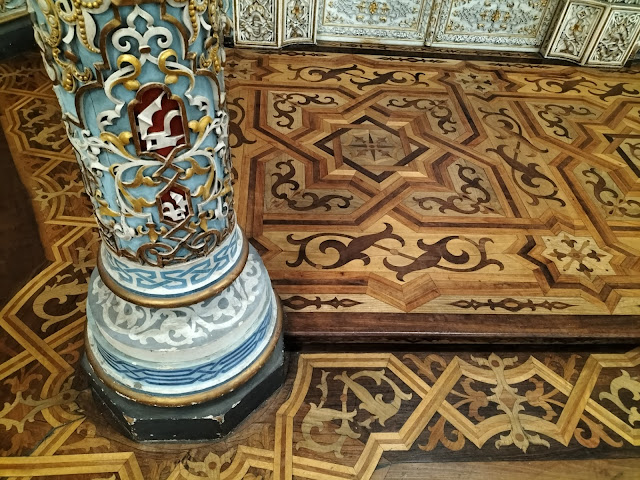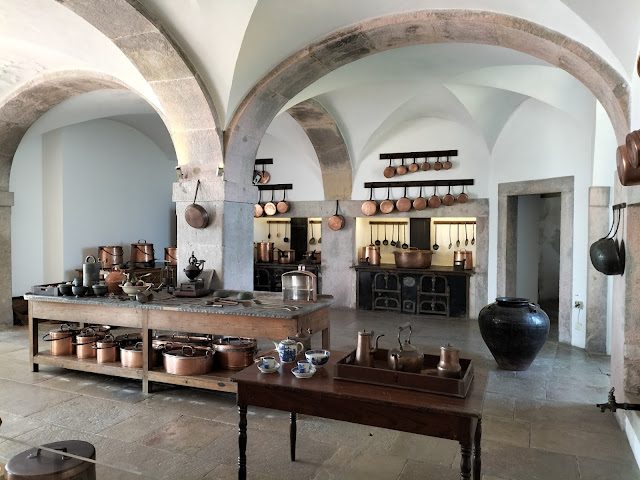Our next port was the very British Gibraltar, famous of course for the Rock and the Barbary Macaques that make it their home.
Approaching Gibraltar on the ship
Driving through the city, our guide pointed out this artwork. Children of all ages are invited to paint the walls and this has cut down graffiti to an absolute minimum.
We were on a small bus - because large buses are unable to navigate the tight tunnels around the peninsula - up to the Rock with an hilarious bus driver/guide named Martin who obviously loves his job. The road to the top is very narrow and steep, so passing other vehicles is quite a feat. Martin stopped the bus at a lookout that afforded us spectacular views of the Strait of Gibraltar.
(The narrow strait connects the Atlantic Ocean to the Mediterranean Sea and separates Europe from Africa. Later, on our sail away from Gibraltar we could see both land masses.)
On the way up Martin told us that the Barbary Macaques run free all over the Rock and warned against feeding them. If one landed on us, we were to 'freeze' until they jumped off, as moving about would only make them hold on tighter and eventually they would bite us on the neck. As you can imagine we got off the bus in fear and trembling. But as it turned out the macaques (very similar to those in City Park, Launceston) stayed where they were for the most part and didn't approach us.


Our tour took us into the Great Siege Tunnels, which were constructed during a Great Siege by the French and Spanish from 1779 to 1783. The work was carried out by hand, using mainly sledgehammers and crowbars, aided by gunpowder blasts. It took 13 men five weeks to dig a tunnel with a length of 25 metres and they were hindered by fumes and dust from the frequent blasting. So, it was decided to blast a horizontal shaft to improve ventilation and this had an unexpected side effect. Cannons were then mounted at the horizontal shafts and this extra firepower changed the outcome of the battle in Britain's favour. In all, there are some 50kms of tunnels under the Rodk.
Martin dropped us back in the city and we headed for the town square where we stopped in at Little Rock Bar & Restaurant, one of many outdoor cafes, for a delicious lunch and cooling wine/ale.
Back to Spain for our last port in that country, Cadiz. We chose to see the city ourselves and what a day we had! It was a short walk to the City Sightseeing Hop-on Hop-off bus and we enjoyed the vista of historic buildings against a backdrop of blue sea and even bluer sky. Cadiz is regarded as the most ancient city still standing in Western Europe, having been settled by the Phoenicians around the 9th Century BC.
The beautiful Genoves Park
The cathedral is another beautiful Baroque building, constructed between 1722 and 1838 and it contains the largest crypt we have ever seen. A walk up the belltower (fortunately, not stairs until right at the top) was well worth the effort.
Lunch was calling so we wandered through the main square and Jim dined on delicious traditional seafood paella. Penny had calamari and our local beer and wine cost 3 Euro (AUD$5) each!
We have met some lovely people on the cruise, including two ladies from Northern Ireland. We sat near them one night for dinner and as we were finishing our main course waiters arrived with a birthday cake which they put in front of Cathy. They began to sing 'Happy Birthday' so of course we joined in. Cathy looked surprised and was laughing as the waiters left. She said that although it was a lovely gesture, her birthday wasn't actually until October. Turns out it was Ann's birthday the following day so the waiter had the wrong date, and the wrong person. But no harm done, and we all had a good laugh.
We had some wonderful entertainment on board, as always, including several 'Hollywood' type shows in the theatre and a number of solo and duo musicians in the various lounges.
We also dined on a lot of delicious food and wonderful European and South American wines...

Our final port of call before Lisbon, was Porto in Portugal where we took a day excursion and saw many of the city's beautiful buildings before stopping at the Palacio da Bolsa, once a monastery and now a public building.
The blue and white tiling is found frequently on buildings in Portugal
Driving through Porto
The detail of the hand-carved granite on the columns was stunning
Inside the beautiful Palacio da Bolsa
We followed the city tour up with a wine tasting at a local winery called Rozes.
Each of the French wine casks on the left holds up to 24,000 litres
Rozes produces 'Porto wine' in white and red varieties. To us, the white tasted more like a sauterne and the red like a light port, but both were delicious.
Very old and valuable wines in storage
Model of a boat used in the old days to cart wine
Interesting shaped wine cask
We debarked in Lisbon the next morning to begin our four days in this historic city. Our taxi ride was like a roller coaster. Our driver sped down narrow and windy streets, barely missing vehicles parked on either side of the road. But we made it safely to the hotel!
Our last visit to Lisbon was in 2015 and the one thing Penny was keen to find again was a Portuguese Tart. Turns out there are pastry stores on almost every corner. It is 'interesting' walking around Lisbon, because you don't just have to look where you're going, you have to watch where you're walking - the footpaths are made from small tiles in patterns and over the years they have come loose and created gaping holes, or the footpath has actually sunk.
They're all like this...
But they lead to the pastry shops
We could write a book just about bathrooms and public toilets. This was the shower in our hotel room in Lisbon - it took quite some effort to actually turn it on!
We spent two full days on day tours, the first as part of a small group tour to the municipality of Sintra about 40 minutes from Lisbon by minibus. The main historic village of Sintra with its original medieval palace is overlooked by the ancient ruins of a Moorish castle. We stopped in the village for coffee and a local delicacy called Travesserio, pillow shaped puff pastry filled with sweet, eggy almond cream and dusted with castor sugar. Very decadent.
Sintra National Palace
Moorish castle on the hill overlooking Sintra
Penny in the Sintra town square
We drove on to
Quinta da Regaleira, a neo-gothic mansion. But the real attraction is the gardens which conceal secret passages, mystical symbolism and even a Knights Templar initiation well. Our guide, Andre, who took us down the secret passages including into the well, explained that we each needed to cross the bridge, lose all our memories, and be reborn as a new person... It didn't work, but it was worth a try. The property was purchased by Antonio Monteiro in 1848 for the equivalent of 125 Euro and he developed it in line with his cultural, philosophical and scientific interests. It is now worth millions.
On the bridge that would help us lose our memories
Descending the well
One of the secret passages
One of the many structures in the gardens
A ziggurat used by the owner to look at the stars with his telescope
The exterior of the mansion
The chapel
Inside the mansion
On to the National Palace of Pena with its vividly painted exterior, and interior restored to how it was in 1910 when the Portuguese nobility fled the country, and it became a republic.
Main entrance
The cloister
Views from the top
The exterior of the palace from the upper levels
In between visits to palaces, we drove to the westernmost point of continental Europe with its dramatic coastline.
We had a traditional Portuguese lunch as a group. We had two guides, Andre who did all the wonderful narration about the castles, and Susanna our driver who did the rest. And our fellow tourists were two couples from California and a woman from Sidmouth in the UK.
It was a long day, 11 hours in all. We literally walked for miles up and down hills, climbed stairs and navigated in and around some enormous buildings. We were exhausted, but very appreciative of everything we had seen and heard.
Some time ago Penny picked up a newsletter at one of our local cafes and read about a library in Portugal where bats are allowed in every night to eat the bugs, to stop them from eating the books. This library, one of the largest in the world, is located inside one of the largest palaces in the world, at Mafra only 45 minutes from Lisbon. So, we booked a tour, not knowing what to expect.
Our exceptional guide and driver Nuno picked us up in a private car and off we went. He asked why we had chosen this particular tour as most people didn't go to Mafra. We explained why and he was amazed, and thrilled that we had chosen to go with him. The tour was so much more than we could have imagined, and we were so pleased we had chosen it.
Our first stop was the National Palace of Queluz, a magnificent palace and gardens compared by some to Versailles near Paris. As we had visited Versailles, we could definitely see the similarities.
Nuno suggested a coffee break so we stopped in a little village called Belas for another local delight, the Fofo (meaning fluff) de Belas. Delicious. Food in Portugal is fairly inexpensive and for three cakes and three coffees the cost was 8 Euro - about $14.
We then ventured on to Mafra. The National Palace of Mafra occupies almost four hectares, has 1,200 rooms, more than 4,700 doors and windows, and 156 stairways, and is Portugal's most important Baroque monument. But is isn't just a palace. It once housed a Franciscan convent with 300 friars, an infirmary, a Basilica (one of the largest we have seen with six organs and 98 bells), and the library. Its sheer size is mind blowing and when we asked why more people don't visit, Nuno's answer was that the Portuguese are not good at marketing...
Part of the infirmary used by the friars to treat patients during wartimes
An inside bird's eye view of the basilica from the top floor of the palace
The Library
Jim, Penny and Nuno
The window used by the bats to enter the library, with a few deceased bats in the foreground
On the way back to Lisbon we called into an historic village of clay made houses developed by one man, Jose Franco, showing life as it was in Portugal as late as the 1980s. There was also a model village on the site.
Lifesize clay houses
And the model village
We leave Portugal now with wonderful memories and move on to London.




















































































































